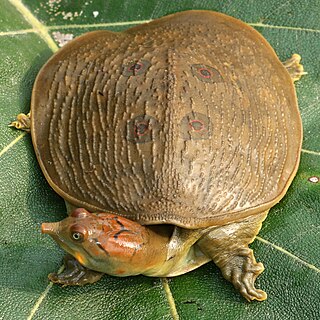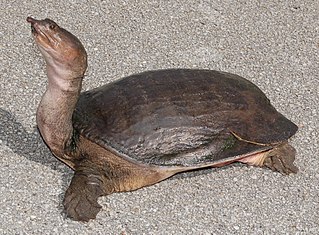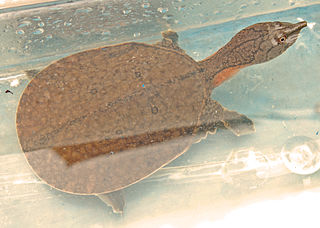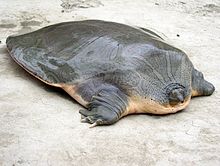
The Trionychidae are a taxonomic family of a number of turtle genera, commonly known as softshell turtles. The family was erected by Leopold Fitzinger in 1826. Softshells include some of the world's largest freshwater turtles, though many can adapt to living in highly brackish areas. Members of this family occur in Africa, Asia, and North America, with extinct species known from Australia. Most species have traditionally been included in the genus Trionyx, but the vast majority have since been moved to other genera. Among these are the North American Apalone softshells that were placed in Trionyx until 1987.

The Indian flapshell turtle is a freshwater species of turtle found in South Asia. The "flap-shelled" name stems from the presence of femoral flaps located on the plastron. These flaps of skin cover the limbs when they retract into the shell. It is unclear what protection the flaps offer against predators. Indian flapshell turtles are widespread and common in the South Asian provinces. It is morphologically an evolutionary link between the softshell and hardshell aquatic turtles. Exploitation for profit and habitat change are threats to their survival.

The Asian giant softshell turtle, also known commonly as Cantor's giant softshell turtle and the frog-faced softshell turtle, is a species of freshwater turtle in the family Trionychidae. The species is native to Southeast Asia. The species is critically endangered and in the 20th century has disappeared from much of its former range.

Leith's softshell turtle is a species of turtle in the family Trionychidae. The species is found in peninsular Indian rivers including the Thungabhadra, Ghataprabha, Bhavani, Godavari, Kaveri and Moyar Rivers. The type locality is Pune in India.

The Indian softshell turtle, or Ganges softshell turtle is a species of softshell turtle found in South Asia in rivers such as the Ganges, Indus and Mahanadi. This vulnerable turtle reaches a carapace length of up to 94 cm (37 in). It feeds mostly on fish, amphibians, carrion and other animal matter, but also takes aquatic plants. This turtle is listed in part II of Schedule I of the Wild Life (Protection) Act, 1972 and possession of this species is an offence.

Chitra is a genus of turtles in the family Trionychidae.

The black pond turtle, also known commonly as the spotted pond turtle and the Indian spotted turtle, is a species of freshwater turtle in the family Geoemydidae. The species, which is endemic to South Asia, belongs to the monotypic genus Geoclemys.

The Indian roofed turtle is a species of turtle in the family Geoemydidae. It can be distinguished by the distinct "roof" at the topmost part of the shell. It is found in the major rivers of South Asia. It is a common pet in the Indian Subcontinent.

The wattle-necked softshell turtle, also commonly known as Steindachner's soft-shelled turtle, is an endangered Asian species of softshell turtle in the family Trionychidae. The species is the only member of the genus Palea.

The Chinese softshell turtle is a species of softshell turtle that is native to mainland China and Taiwan, with records of escapees—some of which have established introduced populations—in a wide range of other Asian countries, as well as Spain, Brazil and Hawaii.

Apalone is a genus of turtles in the family Trionychidae. The three species of Apalone are native to freshwater habitats in North America; they are the only living softshell turtles from the Americas.

The narrow-bridged musk turtle is a species of turtle in the family Kinosternidae. The species is found in Central America and Mexico.

The spiny softshell turtle is a species of softshell turtle, one of the largest freshwater turtle species in North America. Both the common name, spiny softshell, and the specific name, spinifera (spine-bearing), refer to the spiny, cone-like projections on the leading edge of the carapace, which are not scutes (scales).

The Gulf Coast spiny softshell turtle, a subspecies in the Trionychidae family of softshell turtles, is endemic to the south-eastern United States.

The Florida softshell turtle is a species of turtle in the family Trionychidae. The species is native to the Southeastern United States.

The Asian narrow-headed softshell turtle is a large species of softshell turtle in the family Trionychidae. The species is endemic to Southeast Asia.

The Malayan softshell turtle is a species of softshell turtle in the family Trionychidae. It is monotypic in its genus.

Nilssonia is a genus of softshell turtles from rivers, streams, ponds, and lakes in South Asia and Burma. In many treatments, it is monotypic, with the single species Burmese peacock softshell. However, the supposed other genus of peacock softshells, Aspideretes, is more closely related to N. formosa than had been believed. They differ only in the neural plates between the first pleural scale pair of the bony carapace, which are fused into one in N. formosa and unfused in the others.

The Euphrates softshell turtle, also known as the Mesopotamian softshell turtle, is a species of softshell turtle in the family Trionychidae. It is found throughout much of the Euphrates–Tigris river basin in Iraq, Syria, Turkey and Khūzestān Province of Iran. Historically it has also been reported from Iran, but this likely involves confusion with the very similar Trionyx triunguis.
The Burmese narrow-headed softshell turtle, also known commonly as the Myanmar narrow-headed softshell turtle and Van Dijk's chitra, is a species of turtle in the family Trionychidae. The species is endemic to Southeast Asia.



















